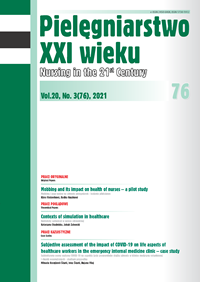Motivation of nurses for raising professional qualifications
DOI:
https://doi.org/10.2478/pielxxiw-2021-0020Keywords:
nurses, education, motivationAbstract
MOTIVATION OF NURSES FOR RAISING PROFESSIONAL QUALIFICATIONS
Aim. The aim of the study was to determine motivating factors for increasing professional qualifications among nurses.
Material and methods. The study was conducted among 104 nurses employed at Samodzielny Publiczny Miejski Zakład Opieki Zdrowotnej (Independent Public Municipal Health Care Centre) in Słupsk, as well as professionally active students of post-graduate master’s degree programme in nursing conducted at the Pomeranian University in Słupsk.
Results. As many as 85.6% of nurses reported improving their professional qualifications in the last ten years, of which 65.4% had completed a specialist course, 33.7% had completed post-graduate education, and 53.8% of the respondents had attended other forms of professional training. The data shows that some nurses have received more than one form of vocational training. Training leave and decisions of superiors had the least influence on the motivation for raising qualifications. The most frequent demotivators from implementing measures aimed at improving qualifications were: lack of time and financial barrier. Superiors, lack of appropriate offer nor need for post-graduate education had the least influence on demotivation.
Conclusions. The main driving factor behind nurses’ decision to raise their professional qualifications is the desire to broaden the knowledge as well as the prospect of pay increase. The most frequently occurring demotivators in taking measures aimed at improving qualifications are the lack of time and financial barriers.
References
1. Kawczyńska-Butrym Z. Wprowadzenie do diagnozy pielęgniarskiej. [w:] Kawczyńska-Butrym Z, (red.) Diagnoza pielęgniarska. Warszawa: Wydawnictwo Lekarskie PZWL, 1999.
2. Bielawska J. Kompetencje zawodowe pielęgniarki. Zeszyty Naukowe Państwowej Wyższej Szkoły Zawodowej im. Witelona w Legnicy. 2012; 8: 5-17.
3. Wrońska I, Sztembis B. Jakość kształcenia podyplomowego pielęgniarek i położnych. Centrum Kształcenia Podyplomowego Pielęgniarek i Położnych. Warszawa, 2001.
4. Waddell D. The effects of continuing education on nursing practice: a meta-analysis. J. Contin. Educ. Nurs. 1992; 23: 164-168.
5. Nowicki G, Chilimoniuk B, Goniewicz M, Górecki M. Możliwości i bariery rozwoju zawodowego pielęgniarek w opinii uczestników specjalizacji w dziedzinie pielęgniarstwa ratunkowego. Probl. Piel. 2012; 20(4): 473-479.
6. Stefańska W. Podstawowe zagadnienia współczesnej pielęgniarki w opiece zdrowotnej. Pielęg. Pol. 2004; 4: 1-2.
7. Grisciti O, Jacocono J. Effectivenes of continuing education programmes in nursing: literature review. J. Adv. Nurs. 2006; 55: 449-456.
8. Cotterill-Walker S.M. Where is the evidence that master’s level nursing education makes a difference to patient care?. A literature review. Nurse. Educ. Today. 2012; 32: 57-64.
9. Centrum kształcenia pielęgniarek i położnych. https://ckppip.edu.pl/opracowania-i-analizy/sprawozdania-z-realizacji-ksztalcenia/(dostęp: 13.02.2021 r.).
10. Bidzińska E, Sobczak MD, Rakowska KA. Motywy podwyższania wykształcenia przez pielęgniarki Wojewódzkiego Szpitala Zespolonego w Elblągu. Probl. Piel. 2007; 15: 197-202.
11. Cisoń-Apanasewicz U, Gaweł G, Ogonowska D, Potok H. Opinie pielęgniarek na temat kształcenia podyplomowego. Probl. Piel. 2009; 17(1): 32-37.
12. Jagodzińska A, Rezmierska L. Czynniki wpływające na podnoszenie poziomu kwalifikacji zawodowych pielęgniarek w ramach kształcenia podyplomowego. Innowacje w Pielęgniarstwie i Naukach o Zdrowiu 2017; 4: 44-60.
13. Nowicki G, Chilimoniuk B, Goniewicz M, i wsp. Możliwości i bariery rozwoju zawodowego pielęgniarek w opinii uczestników specjalizacji w dziedzinie pielęgniarstwa ratunkowego. Probl. Piel. 2012; 20(4): 473-479.
14. Tomaszewska M, Cieśla D, Czerniak J, i wsp. Możliwości doskonalenia zawodowego pielęgniarek – potrzeby a rzeczywistość. Probl. Piel. 2008; 16: 40-47.
15. Błazucka U, Cieślak H. Systemy motywacyjne w pracy pielęgniarki. Pielęg. Pol. 2015; 3(57): 283-287.
Downloads
Published
Issue
Section
License
Copyright (c) 2021 Authors

This work is licensed under a Creative Commons Attribution-NonCommercial-NoDerivatives 4.0 International License.




